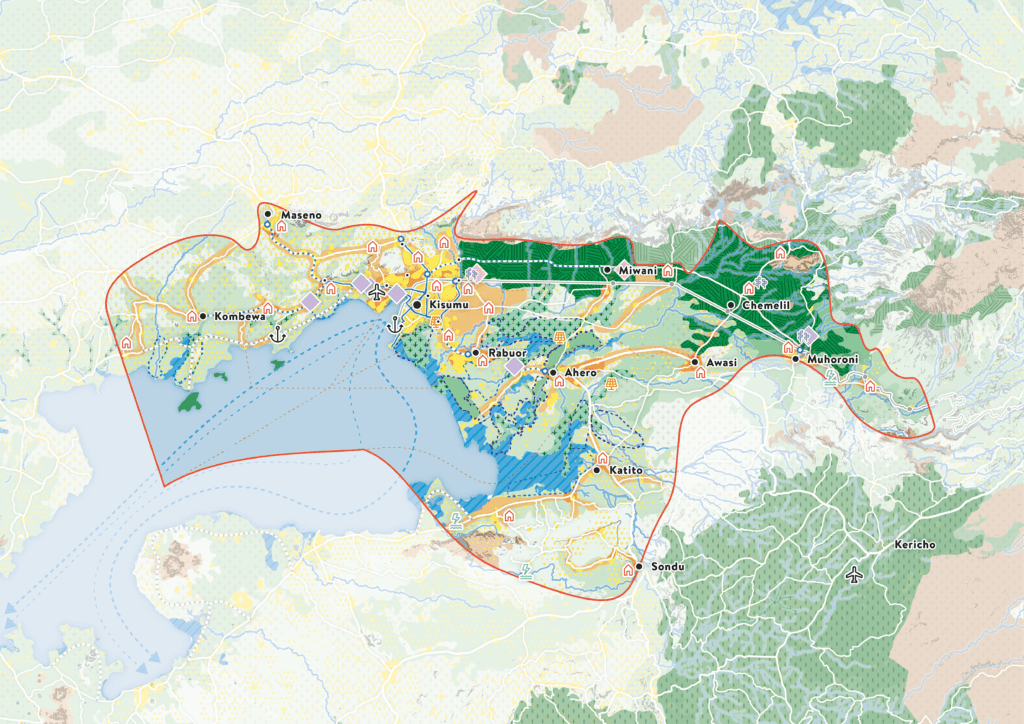
Kisumu County Spatial Planning Framework
Kisumu, Kenya
Project details
Client
Wellcome Trust/Kisumu County
Collaborator
Maseno University
Duration
2020
Services provided by Buro Happold
Climate adaptation and resilience, Environmental, Social and Governance Consulting, Strategic planning
The spatial planning framework for Kisumu County in Kenya has been developed as part of the wider Complex Urban Systems for Sustainability and Health (CUSSH) research project. Buro Happold worked with the spatial planning team at Maseno University and the Kisumu County Government.
The framework explores possibilities for the spatial development of Kisumu County, to inform policymaking and investment into the region as well as the Local Physical Development Plans (LPDPs) currently being prepared for key settlements in the area.
As part of the CUSSH research programme, the framework aims to demonstrate how an integrated approach to spatial planning can help address complex interconnected challenges around sustainability and health and promote enhanced policy impacts. The work is intended to pilot approaches and methodologies that can inform future spatial planning work in Kisumu County and in other locations.
Challenge
Kisumu County is located in western Kenya, covering an area of 2,086 sq km with a population of 1.15 million (in 2019). It is located on Lake Victoria, the second largest freshwater lake in the world, and is part of the wider Kenyan Lake Region with good connectivity to the neighbouring east African countries of Uganda and Tanzania. The county is mostly located on the flat and fertile Kano Plain, and has an important agricultural sector that is the mainstay of its economy.
The county capital, Kisumu City, is the third largest city in Kenya (with around 400,000 people) and is an important commercial and transport hub. Outside Kisumu City, the county is predominantly rural, with various small settlements (up to 20,000 people) serving as local trade and service centres.
Kisumu County is considered a high potential region of Kenya, but its recent economic performance has been lagging relative to its potential. The county faces challenges relating to uneven regional development, agricultural productivity, environmental degradation, waste management, infrastructure provision and vulnerability to drought and climate change.
The county government is pursuing a development agenda including a focus on agro-industry, trade, tourism and service sectors, supported by improved infrastructure and urban services. Kisumu County’s population is expected to nearly double over the next 20 years, adding to pressure on the region’s infrastructure and environmental systems. These opportunities and challenges in Kisumu call for an effective, integrated spatial planning response.
Integrated spatial planning – working across sectors and scales – can help align public and private investment and optimise environmental, economic and social outcomes.

Solution
Effective spatial planning is crucial in rapidly developing regions such as Kisumu County. Unplanned development can quickly embed unsustainable land use patterns with detrimental effects on environmental sustainability, health, equity or economic performance.
As a sub-project of the Wellcome Trust-funded CUSSH project, Buro Happold was engaged to work alongside the County and a team of academics from Maseno University to support spatial planning activities in Kisumu County. Our role has focused on developing a rapid county-scale spatial planning framework which can address the lack of a formal County Spatial Plan; as well as supporting the Maseno University team on the preparation of the four town Local Physical Development Plans (LPDPs).
The Spatial Framework our team developed explores the opportunities for the spatial development of Kisumu County over a 20-year period (from 2020-2040). It is not a formal planning document, but is intended to complement formal planning efforts in Kisumu. We developed the framework after consultation with the Kisumu County Government and a broad range of stakeholders.
The purpose of the plan is to facilitate discussion on the future of the county, inform policy development across multiple sectors, and help guide public and private investment in the absence of a formal County Spatial Plan. It also aims to help set the brief for the LPDPs for Katito, Kombewa, Muhoroni and Sondu – including the future role, purpose and level of growth within each town – resulting in more visionary and forward-looking local plans.
Value
Our experts sought to support CUSSH’s research objectives by exploring how an integrated approach to spatial planning can help address complex interconnected challenges around sustainability and health and promote enhanced policy impacts.
The process allowed us to pilot approaches and methodologies which can inform future spatial planning work in Kisumu County (including a future County Spatial Plan), and in other locations in Kenya or other developing regions.
















